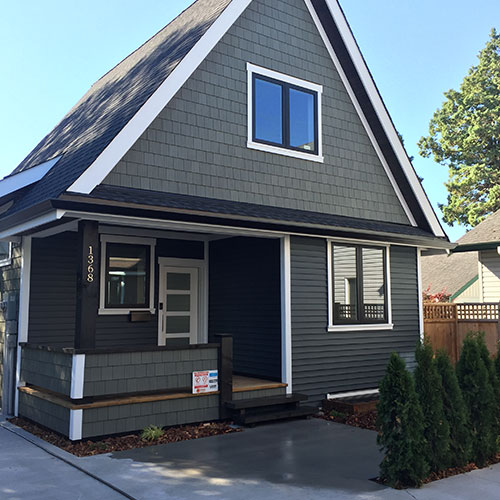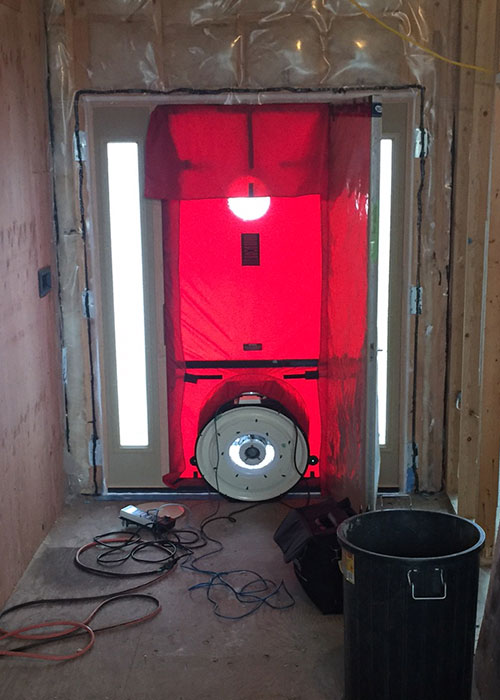BC Energy Step Code
The BC Energy Step Code is the new performance-based standard for the BC Building Code that establishes measurable energy-efficiency requirements for new construction.
New Westminster City Council endorsed local implementation of the BC Energy Step Code on April 9 and December 10, 2018, with subsequent Building Bylaw requirements for the Step Code effective March 31, 2019 for Part 9 residential buildings, and January 1, 2020 for Part 3 multi-unit residential and commercial . The December 10th report also signaled the City’s policy intentions on timing of Step Code requirements beyond 2020, subject to future Council approval.
The BC Energy Step Code is the new performance-based standard for the BC Building Code that establishes measurable energy-efficiency requirements for new construction. To comply, development applicants must demonstrate that their proposed building meets or exceeds a set of defined metrics for the building envelope, mechanical equipment efficiency, and airtightness.
The City has also made a Passive Design Exclusion Zoning Bylaw Amendment to allow incremental increases in FSR (density) in single-detached zones to compensate for thicker insulated walls (from Step level 3 to level 5), and as well as a building height relaxation for homes achieving Step Code level 5 or Passive House.
What is BC Energy Step Code?
The Step Code is a provincial standard that establishes progressive energy performance levels for new buildings, from current BC Building Code, up to Net Zero energy ready buildings, which will be the minimum performance requirement for all new buildings in BC by 2032. The Step Code applies to new residential and commercial buildings. To comply, development applicants must use energy modelling software and on-site air tightness testing to demonstrate that both their design and the constructed building meet Step Code requirements. It is recommended that applicants familiarize themselves with the requirements of the Step Code, as this may affect the design and/or construction of your building. Additionally, it is recommended that applicants become familiar with the usefulness of energy modeling and air tightness testing in helping a project meet Step Code performance requirements.
What Steps did the City adopt?
On April 3rd, 2023, City Council gave final reading to Building Bylaw Amendment No. 8388, 2023, to adopt the BC Energy Step Code in New Westminster.
Beginning on May 1st, 2023 the City’s Step Code requirements have increased to Step 3 for Laneway and Carriage Houses. The City is also developing a longer term strategy to implement levels in the new Zero Carbon Step Code.
| Building Permit applications filed on or after | ||
| Part 9 Residential | January 1, 2020 | May 1, 2023 |
| Single Detached and Semi-Detached Homes | Step 3 | Step 3 |
| Laneway and Carriage Houses | Step 2 | |
| Townhomes and Stacked Townhomes | Step 3 |
| Building Permit applications filed on or after | ||
| Part 3 Multi-Residential | January 1, 2020 | May 1, 2023 |
| Wood-Frame Residential | Step 3 | Step 3 |
| Concrete Residential | ||
| Hotels/Motels◊ | ||
| Part 3 Commercial | January 1, 2020 | May 1, 2023 |
| Office | Step 2 | Step 2 |
| Retail / Mercantile (Group D and E Occupancies) |
*Exception for in-stream applications applies to rezoning applications for buildings such as triplexes, townhomes, and stacked townhomes applies to rezoning applications submitted prior to the step code effective date.
◊NOTE: As of December 10, 2018, Table 10.2.3.3.A in Part 10 of the BC Building Code has separate Step Code metrics from the rest of Group C (Residential) occupancies.

Timelines & In-Stream Applicants
Development planning applications (e.g., development permit, rezoning application, heritage revitalization permit) initiated before the relevant effective dates may be considered ‘in-stream’ for purposes of the immediate Step Code adoption requirements (March 31, 2019 and January 1, 2020 respectively). In-stream applications will only have to meet the energy standards in place at the time of application.
Further information on projects considered in-stream can be found within the applicable bulletins below.
Guidance for Applicants
The City has created a series of bulletins that describe how new Step Code requirements are addressed and captured through the development application process. These bulletins are summarized and linked to below.
Bulletin 1 – Overview for All Applicants
High-level overview of Step Code considerations for both Part 9 and Part 3 applicants. This Bulletin is recommended to be read first and in conjunction with other relevant Bulletins listed below.
- Link to Bulletin 1 – General Information for Applicants – Planning or Development Applications and Building Permits
Bulletin 2 – Part 9 Single Family, Duplex, & Laneway/Carriage Homes
Building Permit applications for new single family, duplex, and laneway/carriage homes will need to demonstrate compliance with BC Energy Step Code and home energy labeling requirements.
- Link to Bulletin 2 – Compliance requirements at Building Permit, mid-construction & occupancy New Part 9 Residential Buildings
Applications Requiring Design Review prior to Building Permit
Bulletin 3 – Part 3 Multi-Unit Residential & Commercial Buildings
Prior to Building Permit, Part 3 buildings will require a Planning Application review prior to issuance of a Development Permit and/or Rezoning. Applicants must show through their energy model that the proposed project will meet or exceed minimum BC Energy Step Code Requirements.
- Link to Bulletin 3 – Design Stage and Building Permit compliance requirements for BC Energy Step Code, New Part 3 Multi-Unit Residential and Commercial Buildings
Bulletin 4 – Heritage Revitalization Agreements
New buildings with a Heritage Revitalization Agreement (HRA) require design review by City staff prior to issuance of a Building Permit. Bulletin 4 describes how Step Code requirements are integrated within the design stage review process.
- Link to Bulletin 4 – Design Stage compliance requirements for BC Energy Step Code New Part 9 and Part 3 buildings on sites with protected heritage buildings
Bulletin 5 – Laneway and Carriage Houses
New laneway and carriage houses require a Development Permit prior to issuance of a Building Permit. Bulletin 5 describes how Step Code requirements are integrated within the design stage review process.
- Link to Bulletin 5 – Design Stage compliance requirements for BC Energy Step Code, New Laneway and Carriage Houses
Bulletin 6 – Duplexes, Triplexes, Quads and Townhomes
Prior to Building Permit, these Part 9 residential projects will require a Planning Application review prior to issuance of a Development Permit and/or Rezoning. Applicants must show through their energy model that the proposed project will meet or exceed minimum BC Energy Step Code Requirements.
- Link to Bulletin 6 – Compliance requirements for BC Energy Step Code New Part 9 Multi-Unit Residential Buildings (Townhouses and Small Multi-Unit Residential Buildings)
Note: It is incumbent on applicants to ensure their proposed building design can meet the City’s Step Code requirements, and revisions to building design may require applicants to reapply for updated rezoning and/or development permit approvals.

Passive Design Exclusion Zoning Bylaw Amendment
The City has made a Passive Design Exclusion Zoning Bylaw Amendment to allow incremental increases in FSR (density) in single-detached zones to compensate for thicker insulated walls in higher performance buildings. This is available for projects seeking to move from Step Code level 3 to Step Code level 5.
Working with an Energy Advisor
Energy Advisors are third-party consultants who have been registered by Service Organizations licensed by Natural Resources Canada (NRCan) to deliver NRCan’s EnerGuide Rating System (ERS), ENERGY STAR® for New Homes and R-2000 programs. An Energy Advisor can provide both energy modelling and airtightness testing – the two compliance services needed to demonstrate compliance under the BC Energy Step Code for Part 9 buildings. For more information on energy advisors, including guidance for finding an energy advisor for your project, visit www.energystepcode.ca/energy-advisors/
Additional Resources and Information
In order to help you with your next project, BC Energy Step Code and the City of New Westminster are happy to provide access to additional information and resources available below.
BC Energy Step Code:
Newsletter
Receive up-to-date information from the Province’s BC Energy Step Code Stakeholder Update
Questions?
If you have additional questions regarding the BC Energy Step Code, visit their website below
Additional Info
For more information including performance requirements, resources for industry, and events
Send an Email
Still have additional questions regarding the BC Energy Step Code? Contact them directly via email
City of New Westminster Resources and Information:
Newsletter
Our ESNW Newsletter includes bulletin updates, education and engagement opportunities, incentives and capacity building opportunities
Questions?
If you have additional questions regarding the City’s Implementation of the BC Energy Step Code call 604.515.3818 or email below
Additional Info
For information on Energy Save New West’s High Performance New Home program including the latest program services and incentives available
Additional Forms
BC Energy Step Code Pre-Construction, Mid-Construction and As-Built compliance verification forms are available below

